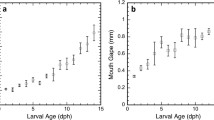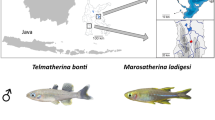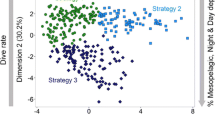Abstract
Although medusan predators play demonstrably important roles in a variety of marine ecosystems, the mechanics of prey capture and, hence, prey selection, have remained poorly defined. A review of the literature describing the commonly studied medusa Aurelia aurita (Linnaeus 1758) reveals no distinct patterns of prey selectivity and suggests that A. aurita is a generalist and feeds unselectively upon available zooplankton. We examined the mechanics of prey capture by A. aurita using video methods to record body and fluid motions. Medusae were collected between February and June in 1990 and 1991 from Woods Hole, Massachusetts and Narragansett Bay, Rhode Island, USA. Tentaculate A. aurita create fluid motions during swimming which entrain prey and bring them into contact with tentacles. We suggest that this mechanism dominates prey selection by A. aurita. In this case, we predict that medusae of a specific diameter will positively select prey with escape speeds slower than the flow velocities at their bell margins. Negatively selected prey escape faster than the medusan flow velocity draws them to capture surfaces. Faster prey will be captured by larger medusac because flow field velocity is a function of bell diameter. On the basis of prey escape velocities and flow field velocities of A. aurita with diameters of 0.8 to 7.1 cm, we predict that A. aurita will select zooplankton such as barnacle nauplii and some slow swimming hydromedusae, while faster copepods will be negatively selected.
Similar content being viewed by others
References
Bailey KM, Batty RS (1983). A laboratory study of predation by Aurelia aurita on larval herring (Clupea harengus): experimental observations compared with model predictions. Mar Biol 72: 195–301
Bailey, KM, Houde KM (1989) Predation on eggs and larvae of marine fishes and the recruitment problem. Adv mar Biol 25:1–83
Bamstedt U (1990) Trophodynamics of the scyphomedusa Aurelia aurita. Predation rate in relation to abundance, size and type of prey organism. J Plankton Res 12:215–229
Brewer RH (1989) The annual pattern of feeding, growth and sexual reproduction in Cyanea (Cnidaria: Scyphozoa) in the Niantic River Estuary, CT. Biol Bull mar biol Lab, Woods Hole 176:272–281
Costello JH (1992) Foraging energetics in hydromedusae. Sci Mar 56:185–191
Costello JH, Marrase C, Strickler JR, Zeller R, Freise AJ, Trager G (1990) Grazing in a turbulent environment: I. Behavioral response of a calanoid copepod, Centropages hamatus. Proc natn Acad Sci USA 87:1648–1652
Daniel TL (1983) Mechanics and energetics of medusan jet propulsion. Can J Zool 61:1406–1420
Daniel TL (1985) Cost of locomotion: unsteady medusan swimming. J exp Biol 119:149–164
de Lafontaine Y, Leggett EC (1988) Predation by jellyfish on larval fish: an experimental evaluation employing in situ enclosures. Can J Fish aquat Sciences 45:1173–1190
Fancett MS (1988) Diet and prey selectivity of scyphomedusae from Port Phillip Bay, Australia. Mar Biol 98:503–509
Fraser JH (1969) Experimental feeding of some medusae and chaetognaths. J Fish Res Bd Can 26:1743–1762
Gamble JC, Hay SJ (1989) Predation by the scyphomedusan Aurelia aurita on herring larvae in large enclosures: effects of predator size and prey starvation. Rapp P-v Réun Cons int Explor Mer 191:366–375
Haury LR, Kenyon DE, Brooks JR (1980) Experimental evaluation of the avoidance reaction of Calanus finmarchicus. J Plankton Res 2:187–202
Heeger T, Moller H (1987) Ultrastructural observations on prey capture and digestion in the scyphomedusa Aurelia aurita. Mar Biol 96:391–400
Huntley ME, Hobson LA (1987) Medusa predation and plankton dynamics in a temperate fjord, British Columbia. J Fish Res Bd Can 34:73–82
Hwang J-S, Costello JH, Strickler JR (1994) Copepod grazing in a turbulent flow: elevated foraging behavior and habituation of escape responses. J Plankton Res 16:421–431
Leonard JL (1982) Transient rhythms in the swimming activity of Sarsia tubulosa (Hydrozoa). J exp Biol 96:181–193
Lindahl O, Hernroth L (1983) Phyto-zooplankton community in coastal waters of western Sweden — an ecosystem off balance? Mar Ecol Prog Ser 10:119–126
Madin LP (1988) Feeding behavior of tentaculate predators: in situ observations and a conceptual model. Bull mar Sci 43:413–129
Matsakis S, Conover RS (1991) Abundance and feeding of medusae and their potential impact as predators on other zooplankton in Bedford Basin (Nova Scotia, Canada) during Spring. Can J Fish aquat Sciences 48:1419–1430
Marrase C, Costello JH, Strickler JR (1990) Grazing in a turbulent environment: II. Energy dissipation, encounter rates and efficacy of feeding currents in Centropages hamatus. Proc natn Acad Sci USA. 87:1653–1657
Mills CB (1981) Diversity of swimming behaviors in hydromedusae as related to feeding and utilization of space. Mar Biol 64: 185–189
Moller H (1980a) Scyphomedusae as predators and food competitors of larval fish. Meeresforsch 28:90–100
Moller H (1980b) Population dynamics of Aurelia aurita medusae in Kiel Bight, Germany (FGR). Mar Biol 60:123–128
Moller H (1984) Reduction of a larval herring population by a jelly-fish predator. Science, NY 224:621–622
Ortin JH (1922) The mode of feeding of the jelly-fish Aurelia aurita, on the smaller organisms of the plankton. Nature, Lond 110:178–179
Purcell JE (1985) Predation on fish eggs and larvae by pelagic cnidarians and ctenophores. Bull mar Sci 37:739–755
Purcell JE (1991) A review of cnidarians and ctenophores feeding on cempetitors in the plankton. Hydrobiologia 216:335–342
Purcell JE, Mills CE (1988) The correlation between nematocyst types and diets in pelagic hydrozoa. In: Hessinger DA, Lenhoff H (eds) The biology of nematocysts. Academic Press, New York, pp 463–485
Southward AJ (1955) Observations on the ciliary currents of the jellyfish Aurelia aurita L. J mar biol Ass UK 34:201–216
Stoecker DK, Michaels AE, Davis LH (1987) Grazing by the jellyfish Aurelia aurita, on microzooplankton. J Plankton Res 9: 901–915
Sullivan BK, Garcia JR, Klein-MacPhee G (1994) Prey selection by the scyphomedusan predator Aurelia aurita. Mar Biol 121:335–341
Author information
Authors and Affiliations
Additional information
Communicated by J. P. Grassle, New Brunswick
Rights and permissions
About this article
Cite this article
Costello, J.H., Colin, S.P. Morphology, fluid motion and predation by the scyphomedusa Aurelia aurita . Marine Biology 121, 327–334 (1994). https://doi.org/10.1007/BF00346741
Received:
Accepted:
Issue Date:
DOI: https://doi.org/10.1007/BF00346741




